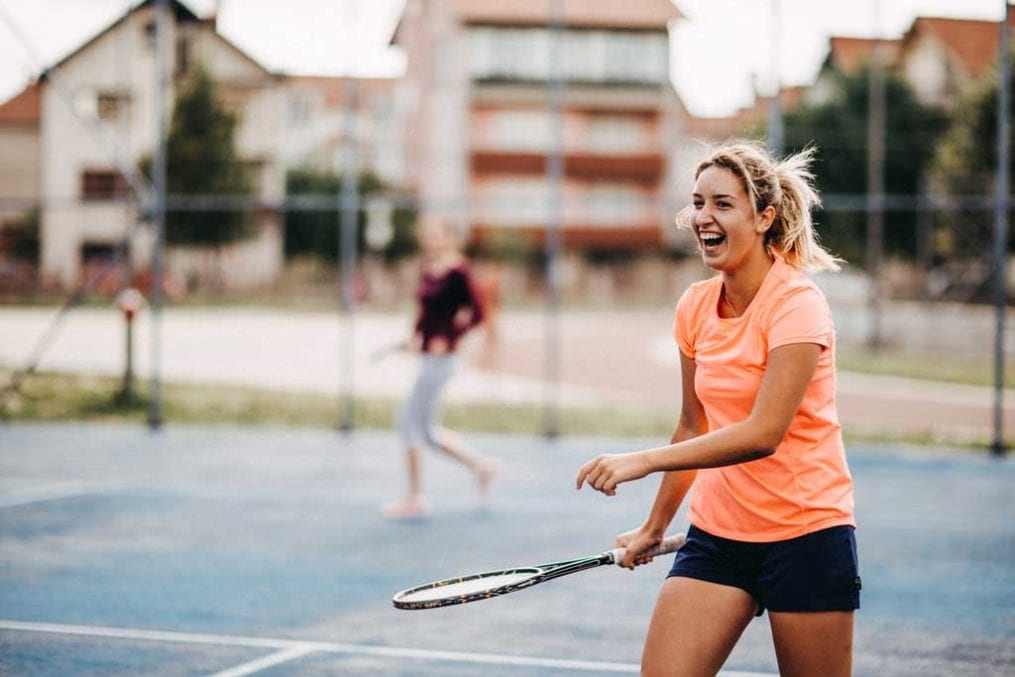
While the decision to cancel Wimbledon this year was a blow for tennis fans, courts reopening safely over the past few weeks have offered some consolation. But whether you’re a seasoned server, or a newbie, now might be a good time to pick up your racket. Tennis is one of the few sports where social-distancing is guaranteed. Plus, it’s an effective workout, exercising your whole body and offering a chance to make friends, too. Follow our tips for beginners’ tennis:
Who can play tennis?
‘Tennis suits all ages and abilities – from four-year-old kids who play mini tennis (with smaller courts and rackets, and lighter balls) to 90-year-olds still playing the full version of the game,’ says Sam Richardson, programmes manager at the Lawn Tennis Association.
Plus, it’s highly social. ‘You’ll make a whole new group of friends if you join a club,’ says Richardson. ‘I’ve been playing for 30 years and I love the competitive side of tennis. Keep the game up and you’ll keep improving, so you can challenge yourself.’
What are the physical benefits of tennis?
Playing tennis challenges your body and is a great fat burner – you can torch around 400 calories an hour on the court. ‘It gives an entire-body workout,’ says Richardson. ‘You’re working your upper body, core and legs as you sprint, jump and lunge to reach your shots. Most tennis beginners are off balance when they hit the ball, so I work on that first,’ says Richardson.
‘There’s been lots of research into the benefits of tennis for the brain, too,’ adds Richardson. ‘You learn to anticipate your opponent’s moves and their weaknesses and need to be able to read the incoming ball. So I encourage people to think about where they need to be on court to make their shot. Plus you’re constantly making decisions during the game – skills that can help you in everyday life.’
Where do I start?
To find somewhere to play, open the ‘Find a Court’ service on the LTA website and type in your postcode to discover a tennis court local to you. There is also an option to find people of a similar standard to play with so you can challenge them to matches.
If you don’t fancy a tennis match but want to get fit, try cardio tennis. This fitness class focuses on moving and burning calories rather than tennis technique. ‘It’s a mix of all types of exercises, so for example, you’ll hit a ball (it doesn’t matter where it goes) then drop down into squats,’ Richardson says.
What tennis kit do I need?
‘All beginners need is a tennis racket – and you can pick one up quite reasonably for around £10 to £20,’ says Richardson. Forget tennis whites, most clubs will let you play in regular sports kit. If you’re playing on a public court in the park, jeans and trainers will do.
The beauty of tennis is that you don’t have to be superfit to play, as it can be adapted to all levels. For example, you can play on a smaller court, using lighter balls. ‘I often see beginners struggling to play with yellow tennis balls, the same type Murray and Nadal use,’ says Richardson, ‘which are heavy with a high bounce. Green or orange are slower and softer, so there’s more chance of hitting them and starting a rally.’
‘The more you play and the better you get, you’ll probably want to invest in a pair of tennis shoes which give you more stability. These cost around £40 to £50,’ advises Richardson. If you want to join a club, an average membership costs from £120 per year – less than most monthly gym fees.
When you’ve caught the tennis bug, stick at it. ‘Tennis isn’t just for summer, it’s a year-round sport,’ says Richardson. ‘Floodlit and indoor courts allow you to play in the winter, too.’ So there’s no reason to stop at as the weather gets colder – your body and brain will thank you for it.
The post How to get started with tennis appeared first on Healthy Magazine | Food | Fitness | Beauty | Health.

No comments:
Post a Comment